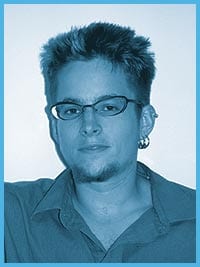The phrase “straight-acting” has always been a turn-off for me. I enjoy being a visible queer who gets noticed. I like making homophobes uncomfortable by my very presence and think of holding hands with a lover in public as a kind of public service announcement.
Before I transitioned people assumed I was lesbian without my saying a word and now, even without my “That’s Mr Trannyfag to you” T-shirt, I am assumed to be gay, and I like that.
The only white picket fence I have ever built was to hide naked lesbians from prying eyes, but lately I have been accused of heterosexual behaviour and, horrors, of being in a heterosexual relationship.
It began gaily enough. We met at a conference, flirted outrageously and went home together to have sex. The morning after we exchanged e-mail addresses and the possibility of a repeat performance.
That first night, gender had been irrelevant. I was so unsure of the gender of my person of desire, that when I was unable to find my him or her, I searched both the men’s and women’s washrooms. No luck in either. Later, and I’m not sure how much later, she told me she was a woman and a dyke.
She has short hair, dark framed glasses, a body that reads as boy with the fashion sense of a very stylish adolescent male. A straight audience’s first interpretation is often that we are two young men. Then we speak, and she sounds like a woman, or she moves and breasts appear under clothing. We kiss, touch and hold each other in intimate, passionate ways in public unlike any gay men I know.
With an uncomfortable glance or a giggle we get re-classified as a het couple, albeit an odd looking one.
Staff in mainstream restaurants seat us at window tables, and grandparents give us approving, knowing smiles. Fag friends over coffee mock me and ask how I am finding straight privilege.
Frankly it has problems. At work I facilitate a group for gay youth, and having a female lover is a bit of a credibility issue. She is a powerful political dyke, who now has a boyfriend. We both struggle so that our queerness continues to be visible. I don’t want to be seen or interpreted as just some sensitive straight guy trying my best to understand what it feels like to be gay or discriminated against. Those who see us as het don’t see my female past or our queer present, and one or both of us becomes invisible.
Gay and lesbian couples get slotted into the same husband and wife, heterosexual roles. Lesbians get asked, “Who’s the man?” and gay men get asked, “Who’s the wife?”
For us, people no longer ask, they assume.
Uncomfortably the lines blur sometimes, and the “I, man, will protect you,” and “girl makes dinner” roles seem a little too scripted and a little too easy. Like anybody, we’ve both been saturated in images of heterosexual relationships and keep discovering small pieces inside ourselves. So we dance our truths, the dyke and the trannyfag, and continue to invent how we fit together in ways that are loving and respectful.
And in the heat of the night, when our bodies come together, gender is still flexible. Some nights she rides my cock, sometimes she spears me on hers, sometimes it’s about pussies being as close as possible. Sometimes the genders we wear slide off and the bodies in bed could be two fags, two dykes, or a man and a woman. All of it can shift at a moment’s notice.
We are still queer among queers. On Pride Day, as we wandered the streets in matching body harnesses, we garnered more than our share of attention. More than once we were asked if we were boys or girls. People stared and took photos. I was truly flattered when a drag queen asked if I had grown my own tits and what dosage of hormones had I taken. I relish the queerness of confusing people as they try to fit the two of us into their understanding of love and relationships.
Most of the time I am a bearded, breasted, trannyboy who is with a fabulous lesbian lover. In the eyes of the law we are two women, and in the eyes of the straight majority we are hetero-sexuals. At times we are fags. Separately, we get read as a dyke and a fag. Together, our opportunities for coming out and challenging expectations have shifted. We challenge the assumptions of as many queer heads as we do straight people, and challenge others to see how our identities as individuals have not changed in the context of our relationship.
I need to expand my T-shirt collection. I want one of those T-shirts that reads, “I’m not a lesbian, but my girlfriend is,” and underneath I want to add, “Ask us how.”

 Why you can trust Xtra
Why you can trust Xtra


